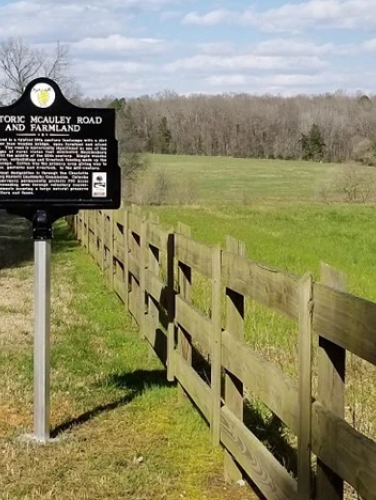
McAuley Road Farmland
(ca. 1889)
The largest surviving area that still reflects the once prevalent rural and agricultural character of Mecklenburg County.
15615, 16101, 16040, 16030, 15832 McAuley Road, Huntersville, NC 28078
The McAuley Road Farmland represents the best preserved and most intact rural-agricultural landscape in Mecklenburg County. From its formation as a county in 1762 until 1900, the county exhibited a distinctly agrarian character. But economic and industrial innovations during the 19th century led to astounding development and population growth at the turn of the century, primarily due to the rapid spread of railroads, the growth of the City of Charlotte, and the expansion of the textile industry. With the phenomenal growth of Charlotte and Mecklenburg County during the 20th century, the McAuley Road Farmland is the last large area of the county that accurately depicts for the public the county’s once dominant late 19th century and early 20th agricultural character.
Property Quick Links
In 1870, only one out of five Mecklenburg County residents lived in Charlotte. Forty years later, more people lived in Charlotte than in the rest of the county. By 1930, Charlotte was the largest city in the Carolinas with 82,675 residents. Good railroads combined with a strong tradition of boosterism encouraged industrial growth, primarily in textiles. By 1902, half of the textile production in the entire southern United States occurred within one hundred miles of Charlotte. The towns of Pineville, Cornelius, Huntersville, and Davidson also featured cotton mills that produced a range of textile products from the cotton cultivated throughout the county, attracting more workers and prompting ever-expanding housing.
In Mecklenburg County, like much of the South, cotton remained the main cash crop until around 1920 with the onset of the boll weevil. The pest devastated the crop, making cultivation more difficult and expensive. Increased costs and declining prices resulted in a 50% drop in cotton production in Mecklenburg County during the 1930s. Changes in agricultural practices also contributed to the decline in farming. Good roads, refrigeration, and the development of modern grocery stores made proximity to the market less important, allowing larger and more efficient farms in other parts of North Carolina and other regions to compete more effectively with the county’s local farms. That increased competition and strong local demand for land for housing, industry, and uses other than farming further contributed to the decline of agriculture throughout Mecklenburg County.
The majority of Mecklenburg County’s early 20th-century farmers were not subsistence farmers but tenants, and most of those tenants were sharecroppers. Agricultural reformers of the day saw tenancy as a serious obstacle to improved farming, arguing that tenancy kept farmers trapped in poverty and debt, as most tenant farmers used short-term loans to finance their crops. The countryside around McAuley Road Farmland bears evidence of this practice, as each farm contains examples of ruined former tenant houses. McAulay Road itself appears to have been constructed to serve those tenants. An extant tenant farmhouse and barn on the former W. C. McAulay property along this road offer a rare insight into the lives of the families that once lived and worked in this area. Early 20th century records associated with this area indicate that several of the properties in the McAulay Road area were owned and cultivated by African American farmers who relied on their own labor as well as hired tenants to cultivate the land. By the mid-20th century, most farmers in this area had transitioned from cotton farming to beef production, using the land for pastures and hay and grain cultivation.

